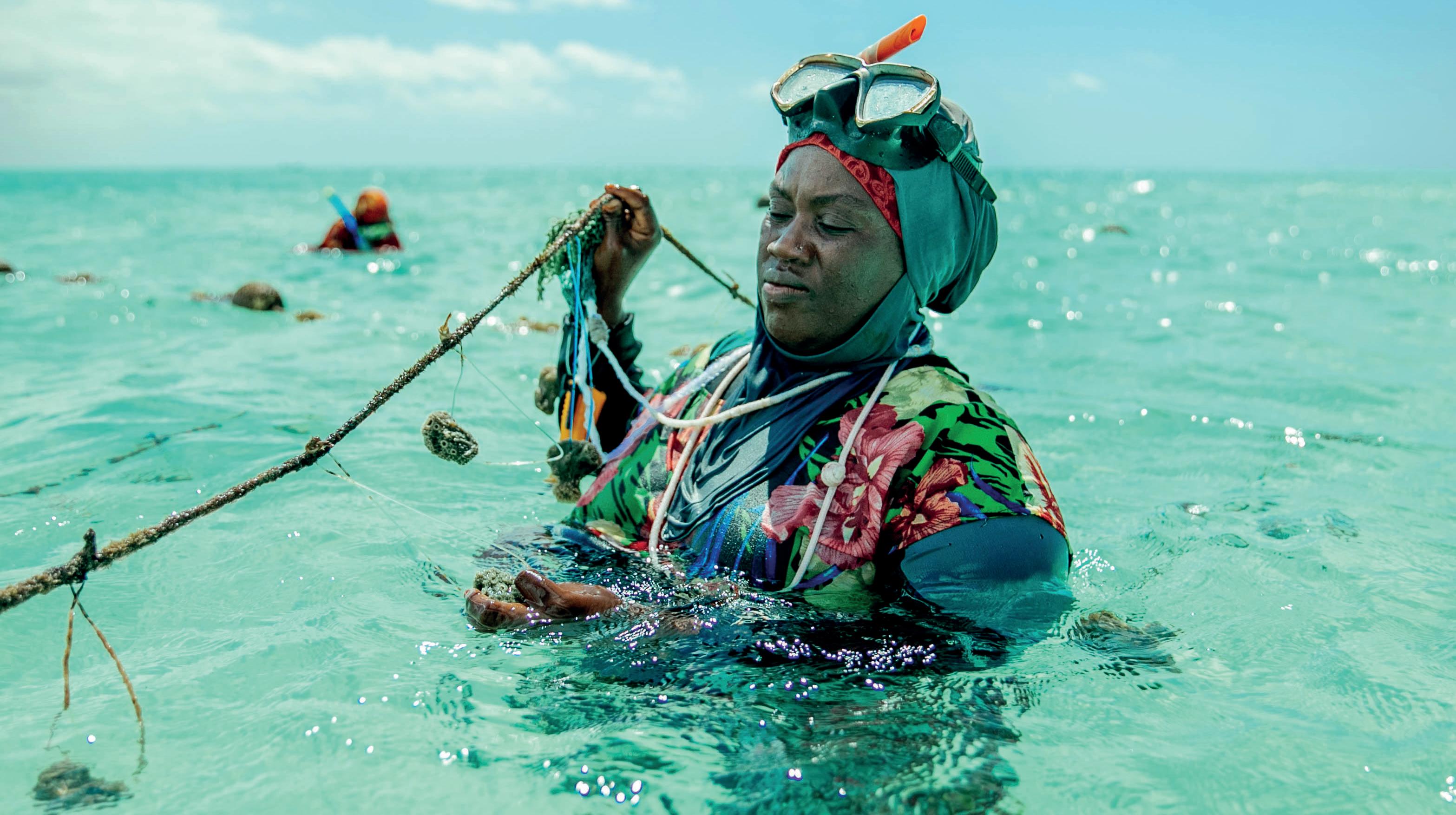
AMID THE refreshing breeze caressing Zanzibar's Jambiani coast, Hindu Rajabu wades through knee-deep water to a lagoon. Wearing swimming goggles and a snorkel perched on her headscarf, the 31-year-old mother of two cautiously navigates the Indian Ocean to locate her floating sponge farm.
Rajabu is among a handful of women in Jambiani village who in 2020 started to cultivate natural sponges. These fascinating animals are made of loosely arranged cells that surround a skeleton of fibres. The specialised cells, nestled within thousands of tiny chambers, act as microscopic pumps, tirelessly drawing water into the sponge's body with their whip-like tails. This unique pumping mechanism, which helps sponges extract nutrition and oxygen, also purifies the ocean water by removing impurities, including sewage. These sponges are also used for bathing and general hygiene because they are naturally antibacterial and antifungal and can resist odours.
With the tide gently rising, Rajabu submerges herself to reach the buoys cradling the sponge farm. Carefully, she inspects the sponges, suspended from thick polyethylene ropes. Using a knife, she removes any fouling organisms, such as bacteria and fish, which have attached themselves to the ropes. This periodic cleaning is essential to prevent the sponges from being overwhelmed by these unwanted inhabitants. The sponge farms are made of multiple ropes that run parallel to each other. They have sponges at different development stages. "We usually harvest them once a week when we collect the sponges that are big enough to be sold in the market," says Rajabu. Women typically dive deep into the ocean to collect healthy wild sponges, which serve as the foundation for their farms that are set up close to the seashore where water is up to two metres deep. These sponge colonies are then carefully cultivated and fragmented to promote new growth.
この記事は Down To Earth の December 16, 2023 版に掲載されています。
7 日間の Magzter GOLD 無料トライアルを開始して、何千もの厳選されたプレミアム ストーリー、9,000 以上の雑誌や新聞にアクセスしてください。
すでに購読者です ? サインイン
この記事は Down To Earth の December 16, 2023 版に掲載されています。
7 日間の Magzter GOLD 無料トライアルを開始して、何千もの厳選されたプレミアム ストーリー、9,000 以上の雑誌や新聞にアクセスしてください。
すでに購読者です? サインイン

In leading role again
MOVIES AND WEB SERIES ARE ONCE AGAIN BEING SET IN RUSTIC BACKGROUNDS, INDICATING A RECONNECT BETWEEN CINEMA AND THE COUNTRYSIDE

One Nation One Subscription comes at a huge cost
As top US universities scrap big deals with top scientific publishers, India’s ONOS scheme seems flawed and outdated

Return of Rambhog
Bid to revive and sell the aromatic indigenous paddy variety has led to substantial profits for farmers in Uttar Pradesh's Terai region

Scarred by mining
Natural springs of Kashmir drying up due to illegal riverbed mining

Human-to-human spread a mutation away
CANADA IN mid-November confirmed its first human case of avian influenza, with a teenager in the British Columbia being hospitalised after contracting the H5N1 virus that causes the disease. The patient developed a severe form of the disease, also called bird flu, and had respiratory issues. There was no known cause of transmission.

True rehabilitation
Residents of Madhya Pradesh's Kakdi village take relocation as an opportunity to undertake afforestation, develop sustainable practices

INESCAPABLE THREAT
Chemical pollution is the most underrated and underreported risk of the 21st century that threatens all species and regions

THAT NIGHT, 40 YEARS AGO
Bhopal gas disaster is a tragedy that people continue to face

A JOKE, INDEED
A CONFERENCE OF IRRESPONSIBLE PARTIES THAT CREATED AN OPTICAL ILLUSION TO THE REALITY OF A NEW CLIMATE

THINGS FALL APART
THE WORLD HAS MADE PROGRESS IN MITIGATING EMISSIONS AND ADAPTING TO CLIMATE IMPACTS. BUT THE PROGRESS REMAINS GROSSLY INADEQUATE